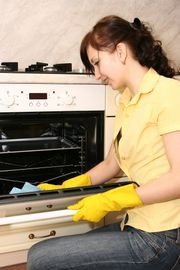A Guide to Self-Cleaning Ovens

Many modern ovens come with a self-cleaning option so that busy homeowners can remove food residue easily. However, some people don’t use this feature since the appliance heats to a high temperature for a long period. Use this guide to learn more about the process to make the most of what your oven has to offer.
How They Work
Once you begin a cycle on a self-cleaning oven, the door will lock shut and the appliance will begin to heat. Temperatures will slowly climb to over 900 degrees over the course of several hours. The heat incinerates food waste on the interior surfaces, which falls as ash. It’s common for small flare-ups to occur as the residue burns. To reduce the risk of fire, clear large chunks of debris before running the cycle. Once the process ends, and the oven cools, sweep away the ash and wipe the interior.
How to Use the Self-Cleaning Function
 Remove any pots, pans, and racks inside the appliance before starting a self-cleaning cycle, as the intense heat will damage them. While the oven is running, open the house’s windows and turn on any ventilation fans to clear fumes or scents created from the process. Once the cycle ends, wait for the oven to cool before replacing the racks.
Remove any pots, pans, and racks inside the appliance before starting a self-cleaning cycle, as the intense heat will damage them. While the oven is running, open the house’s windows and turn on any ventilation fans to clear fumes or scents created from the process. Once the cycle ends, wait for the oven to cool before replacing the racks.
Since high-temperatures wear ovens quickly, self-cleaning cycles should only be used once every three to six months. Performing it more frequently may cause burn fuses and other essential heating elements. Between cycles, clean the oven with a mild soap—don’t use commercial oven cleaners, as they may harm the appliance.
If your oven is experiencing damage from too many self-cleaning cycles, turn to the team at Carolina Appliance Service in Matthews, NC. These experienced professionals will assess the oven to diagnose the issue, then make any necessary repairs to ensure it can continue self-cleaning. Visit the website to get more information about their services, or call (704) 847-0004 to schedule an appointment.
About the Business
Have a question? Ask the experts!
Send your question

